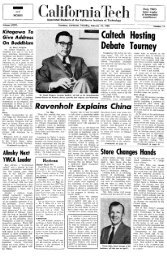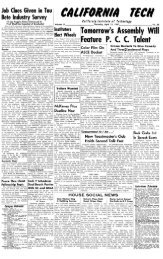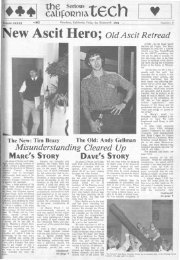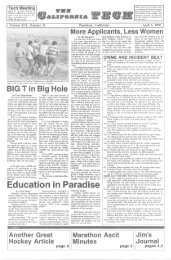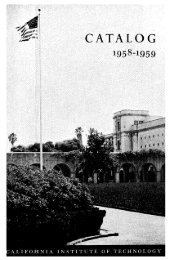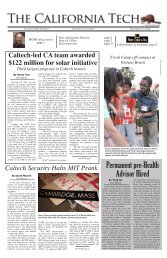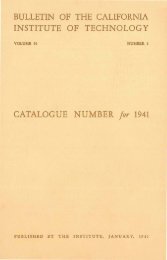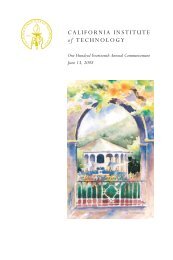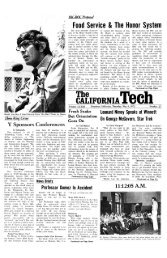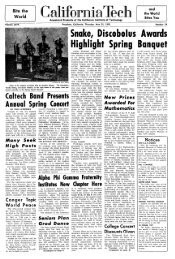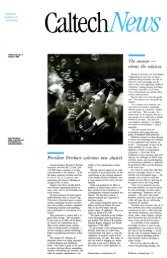CALTECH NEWS - CaltechCampusPubs
CALTECH NEWS - CaltechCampusPubs
CALTECH NEWS - CaltechCampusPubs
You also want an ePaper? Increase the reach of your titles
YUMPU automatically turns print PDFs into web optimized ePapers that Google loves.
u.s. faces shortage<br />
of well-trained<br />
you ng people,<br />
Bloch asserts<br />
Continued from page 1<br />
Meanwhile, there are approximately<br />
1,600 vacant engineering faculty<br />
positions (eight percent of the<br />
total), and half of these have gone<br />
unfilled since 1984, Bloch said.<br />
He addt>d that by 1993, the demand<br />
for PhDs in the natural<br />
sciences and engineering in academic<br />
institutions could be more than double<br />
that for 1983.<br />
But meanwhile, colleges and<br />
universities are awarding a smaller<br />
percentage of degrees in science and<br />
engineering than they did during the<br />
1960s. And more than half of new<br />
engineering PhDs in recent years<br />
have been foreign nationals. Overall,<br />
Bloch pointed out, foreign students<br />
have accounted for almost 86 percent<br />
of the growth of graduate education<br />
in the United States.<br />
"One could almost believe that,<br />
among U.S. citi.lens, pursuing the<br />
PhD track is considered an unAmerican<br />
activity, he quipped.<br />
"These trends are important because<br />
the investment (or its absence)<br />
in human resources today will be reflected<br />
in the achievements of the<br />
next generation of scientists and engineers<br />
over the next several decades,"<br />
said Bloch.<br />
Turning the trends around wiil be<br />
made more difficult because of dtmographic<br />
patterns, he noted. For example,<br />
the number of 22-year-olds will<br />
drop steadily after 1987. This means<br />
that unless a larger percentage of<br />
undergraduates is attracted to science<br />
and engineering, the number earning<br />
degrees in these fields will drop.<br />
"The time is gone," said Bloch,<br />
"when white male graduates alone<br />
can fill all our needs." This means, he<br />
continued, that more women and<br />
members of minorities are needed in<br />
science and engineering to help fill<br />
the shortfall.<br />
"We must focus on underrepresented<br />
groups not only for reasons of<br />
equity," he noted, "but because they<br />
are a vital element in our future<br />
productivity. "<br />
To solve the problem, said Bloch,<br />
"it must be attacked at all levels and<br />
in all its elements" -beginning with a<br />
reversal of what he termed "the serious<br />
underfunding of civilian basic research<br />
since the late 1960s." Also<br />
crucial is a restructuring of the<br />
relationships that have evolved<br />
among the federal government,<br />
universities, and industries.<br />
These major educational issues<br />
must be addressed, he asserted:<br />
• Efforts must be made to improve<br />
primary and secondary education in<br />
the country, particularly in the<br />
sciences and mathematics.<br />
• Everything possible must be<br />
done to attract more young peopleincluding<br />
women and minoritiesinto<br />
careers in science and<br />
engineering.<br />
• The undergraduate curriculum<br />
must be improved in terms of effectiveness<br />
and productivity. Nationwide,<br />
science, math, and engineering<br />
education at this level has<br />
deteriorated.<br />
• Programs to reduce minority<br />
drop-out rates must be given<br />
priority.<br />
• The perception must be changed<br />
that law and business students will<br />
fare better in their future careers than<br />
will science and engineering majors.<br />
• More individuals must be attracted<br />
to the PhD track through better<br />
research opportunities and<br />
facilities, and a better reward system.<br />
• Requirements of the PhD track,<br />
in some instances, should be reevaluated.<br />
For example, eight years may<br />
be too long to earn a PhD in engineering<br />
after completing a BS degree.<br />
In conclusion, Bloch stressed that<br />
"our investment in science and engineering<br />
talent-and in researchpays<br />
enormous dividends to our<br />
society in the long run. It must be<br />
handled with foresight and protected<br />
from short-term shifts that don't consider<br />
ultimate consequences.<br />
"Current levels of support for research<br />
and education are not enough.<br />
We must significantly increase the resources<br />
available to the institutions<br />
that educate our talent and perform<br />
our research.<br />
"We must also forge strategies to<br />
make more effective use of the resources<br />
at our disposal in support of<br />
research and education. Industryuniversity<br />
cooperation, for example,<br />
creates unique educational opportunities<br />
for the next generation of<br />
researchers."<br />
In conclusion, Bloch told his audience<br />
that "pluralism of institutions,<br />
strategies, and views has always been<br />
this country's major strength. To<br />
make the best possible use of our rich<br />
human resource base, we need a<br />
new, forceful partnership of those<br />
who have a stake in our future: That<br />
means all of us."<br />
Mrs. Knox Farrand, whose husband is the son of founder George E. Farrand, Dr. lohn D.<br />
Roberts, Mrs. Andrew D. Farrand, whose husband is the grandson of founder George E.<br />
Farrand; Dr. Lee A. DuBridge; and Mrs. John E. Barber, widow John E. Barber.<br />
Dr. Marvin L. Goldberger, Erich Bloch, and Mrs. Vernon Barrett.<br />
Mrs. Reese H. Taylor, widow of<br />
Associates founder Reese Hale Taylor,<br />
with Mrs. Elise Mudd Marvin, granddaughter<br />
of founder Seeley W. Mudd.<br />
Associates recall<br />
1926 founding<br />
Soft platinum tones celebrating 60<br />
years of service set the mood in the<br />
Athenaeum for the annual reception<br />
and dinner of The Associates on October<br />
9, as the group celebrated its<br />
1926 founding. After dinner, the Art<br />
Deco Society Orchestra played music<br />
for dancing from the 1920s<br />
and 1930s.<br />
Richard L. Hayman, president of<br />
The Associates, welcomed the 330<br />
guests. He noted that in 1926, the<br />
great literary happenings were publication<br />
of The Sun Also Rises, Winnie<br />
the Pooh, and The Little Engine that<br />
Could. He quoted Robert A. Millikan,<br />
who once said that "the founding<br />
of The Associates constituted the



